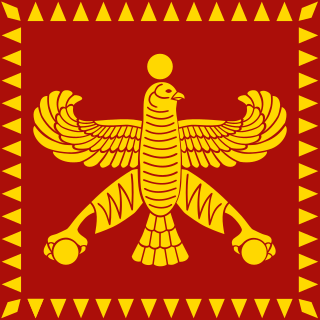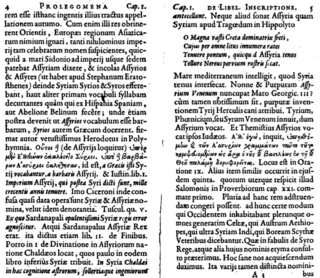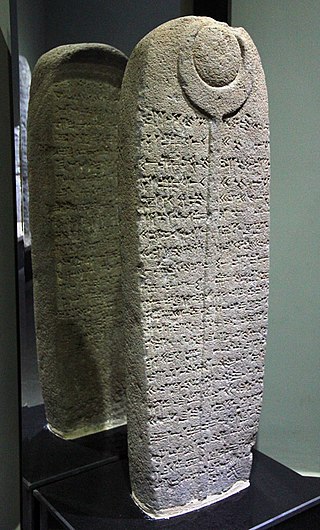Related Research Articles
The Levant is the area in Southwest Asia, south of the Taurus Mountains, bounded by the Mediterranean Sea in the west, the Arabian Desert in the south, and Mesopotamia in the east. It stretches roughly 400 mi (640 km) north to south, from the Taurus Mountains to the Sinai desert and Hejaz, and east to west between the Mediterranean Sea and the Khabur river. The term is often used to refer to the following regions or modern states: the Hatay Province of Turkey, Syria, Lebanon, Israel, Palestine, and Jordan. The term sometimes include Cilicia, Cyprus and the Sinai Peninsula.

Babylonia was an ancient Akkadian-speaking state and cultural area based in the city of Babylon in central-southern Mesopotamia. It emerged as an Akkadian populated but Amorite-ruled state c. 1894 BC. During the reign of Hammurabi and afterwards, Babylonia was retrospectively called "the country of Akkad", a deliberate archaism in reference to the previous glory of the Akkadian Empire. It was often involved in rivalry with the older ethno-linguistically related state of Assyria in the north of Mesopotamia and Elam to the east in Ancient Iran. Babylonia briefly became the major power in the region after Hammurabi created a short-lived empire, succeeding the earlier Akkadian Empire, Third Dynasty of Ur, and Old Assyrian Empire. The Babylonian Empire rapidly fell apart after the death of Hammurabi and reverted to a small kingdom centered around the city of Babylon.

Tiglath-Pileser III was the king of the Neo-Assyrian Empire from 745 BC to his death in 727. One of the most prominent and historically significant Assyrian kings, Tiglath-Pileser ended a period of Assyrian stagnation, introduced numerous political and military reforms and more than doubled the lands under Assyrian control. Because of the massive expansion and centralization of Assyrian territory and establishment of a standing army, some researchers consider Tiglath-Pileser's reign to mark the true transition of Assyria into an empire. The reforms and methods of control introduced under Tiglath-Pileser laid the groundwork for policies enacted not only by later Assyrian kings but also by later empires for millennia after his death.

Shalmaneser III was king of the Neo-Assyrian Empire from the death of his father Ashurnasirpal II in 859 BC to his own death in 824 BC.
The Arameans, or Aramaeans, were an ancient Semitic-speaking people in the Near East that was first recorded in historical sources from the late 12th century BC. The Aramean homeland, sometimes known as the land of Aram, encompassed central regions of modern Syria.

Aram was a historical region mentioned in early cuneiforms and in the Bible, populated by Arameans. The area did not develop into a larger empire but consisted of a number of small states in present-day Syria. Some of the states are mentioned in the Old Testament, Damascus being the most outstanding one, which came to encompass most of Syria. Furthermore, Aram-Damascus is commonly referred to as simply Aram in the Old Testament.

Shamshi-Adad V was the King of Assyria from 824 to 811 BC. He was named after the god Adad, who is also known as Hadad.

Tukulti-Ninurta II was King of Assyria from 890 BCE to 884 BCE. He was the second king of the Neo Assyrian Empire.
Adad-nīrārī II reigned from 911 BCE to 891 BCE. He was the first King of Assyria in the Neo-Assyrian empire. He instigated the first renewed period of major expansion following that of the Middle Assyrian Empire which had begun in 1365 BCE under Ashur-uballit I and ended after the death of Ashur-bel-kala in 1053 BCE.

The Kingdom of Aram-Damascus was an Aramean polity that existed from the late-12th century BCE until 732 BCE, and was centred around the city of Damascus in the Southern Levant. Alongside various tribal lands, it was bounded in its later years by the polities of Assyria to the north, Ammon to the south, and Israel to the west.

The states called Neo-Hittite, Syro-Hittite, or Luwian-Aramean were Luwian and Aramean regional polities of the Iron Age, situated in southeastern parts of modern Turkey and northwestern parts of modern Syria, known in ancient times as lands of Hatti and Aram. They arose following the collapse of the Hittite New Kingdom in the 12th century BCE, and lasted until they were subdued by the Assyrian Empire in the 8th century BCE. They are grouped together by scholars, on the basis of several cultural criteria, that are recognized as similar and mutually shared between both societies, northern (Luwian) and southern (Aramaean). Cultural exchange between those societies is seen as a specific regional phenomenon, particularly in light of significant linguistic distinctions between the two main regional languages, with Luwian belonging to the Anatolian group of Indo-European languages and Aramaic belonging to the Northwest Semitic group of Semitic languages. Several questions related to the regional grouping of Luwian and Aramaean states are viewed differently among scholars, including some views that are critical towards such grouping in general.

Bit Adini, a city or region of Syria, called sometimes Bit Adini in Assyrian sources, was an Aramaean state that existed as an independent kingdom during the 10th and 9th centuries BC, with its capital at Til Barsib. The city is considered one of the two chief states of the Aramean-held territories in the Euphrates along with Carchemish.

Eber-Nari or Ebir-Nari (Akkadian), also Abar-Nahara (Aramaic) or Aber Nahra (Syriac), was a region of the ancient Near East. Translated as "Beyond the River" or "Across the River" in both the Akkadian and Aramaic languages, it referred to the land on the opposite side of the Euphrates from the perspective of Mesopotamia and Persia. In this context, the region is further known to modern scholars as Transeuphratia. Functioning as a satrapy, it was originally administered by the Neo-Assyrian Empire before being absorbed by the Neo-Babylonian Empire and then by the Achaemenid Empire. During the Greek conquest of Persia, Eber-Nari was, like the rest of the Achaemenid Empire, annexed by the Macedonian Empire of Alexander the Great. It was later dissolved by the Seleucid Empire, which incorporated it into Syria, along with Assyria.

During the Middle Assyrian Empire and the Neo-Assyrian Empire, Phoenicia, what is today known as Lebanon and coastal Syria, came under Assyrian rule on several occasions.

The name Syria is latinized from the Greek Συρία. In toponymic typology, the term Syria is classified among choronyms. The origin and usage of the term has been the subject of interest, both among ancient writers and modern scholars. In early Hittite, Luwian, Cilician and Greek usage between the 9th century BC and 2nd century BC, the terms Συρία (Suría) and Ασσυρία (Assuría) were used almost interchangeably. In the Roman Empire, the terms Syria and Assyria came to be used as names for distinct geographical regions. "Syria" in the Roman period referred to the region of Syria, while Assyria was part of the Parthian Empire and then Sasanian Empire and only very briefly came under Roman control, AD 116–118, marking the historical peak of Roman expansion. Henceforth, the Greeks then applied the term "Syrian" without distinction between the actual Assyrians of Mesopotamia, Northeast Syria and Southeast Anatolia, and now also to the Arameans and Phoenicians of the Levant who had not previously had the term applied to them or their lands.

King Kapara was an Aramean king of Bit Bahiani, one of the Post-Hittite states, centered in Guzana. He ruled sometime in the 10th or 9th century BCE, according to some estimations ca. 950-875 BCE. He built Bit-hilani, a monumental palace in Post-Hittite style, discovered by Max von Oppenheim in 1911, with a rich decoration of statues and relief orthostats.

The Ahlamu; or Aḫlamū, were a group or designation of Semitic semi-nomads. Their habitat was west of the Euphrates between the mouth of the Khabur and Palmyra.

The Pazarcık Stele is an Assyrian monument which functioned as a boundary stone erected by the Assyrian king Adad-nirari III in 805 BC to demarcate the border between the kingdoms of Kummuh and Gurgum. The reverse and obverse of the stele have been inscribed in the Akkadian language in different times.

The timeline of ancient Assyria can be broken down into three main eras: the Old Assyrian period, Middle Assyrian Empire, and Neo-Assyrian Empire. Modern scholars typically also recognize an Early period preceding the Old Assyrian period and a post-imperial period succeeding the Neo-Assyrian period.
References
- ↑ Mynářová, Jana; Dušek, Jan (9 April 2019). Aramaean Borders Defining Aramaean Territories in the 10th – 8th Centuries B.C.E. Brill. p. 41. ISBN 9789004398535.
- ↑ Georges Roux, Ancient Iraq pp. 280-281
- ↑ Mynářová, Jana; Dušek, Jan (9 April 2019). Aramaean Borders Defining Aramaean Territories in the 10th – 8th Centuries B.C.E. Brill. p. 41. ISBN 9789004398535.
- ↑ Healy, Mark (1991). The Ancient Assyrians. New York: Osprey. p. 10.
- ↑ Georges Roux, Ancient Iraq p. 297
- ↑ Georges Roux, Ancient Iraq p. 309